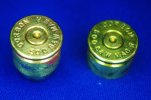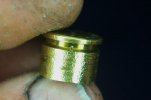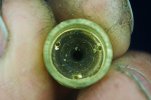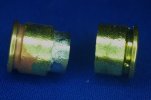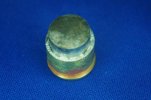By cutting a shallow shoulder in the handle for the rim, and a body hole that fits the casing , the rivet acts like a Corby.
All this is done after the handle is assembled and sanded. You can not put the rivets in before without ruining them in the sanding and shaping stages. You can put a piece of dowel rod in the holes while shaping, and tap it out when ready to install the bullet casings. If it won't tap out, drill it out. You will need to drill the rivet holes and shoulders for the casings anyway.
What I do is cut the two casings so they are just a tad short of the total length of the handle rivet needed. I then take a piece of round stock that snugly fits the inside of the casings. I rough up the rod , and glue the rod in one casing. After the epoxy is cured, I clean it up and cut the rod to the length to allow the other casing to fit on it and make the right rivet length ( I make it a tad shorter to allow for Murphy). I rough up the outside of both casings, put the male piece in from one side and the female from the other, and epoxy the assembly into the handle.A spring clamp holds it in place while curing. Make sure the casings heads are turned the way you want them before pressing them flush, as it is hard to move them once pressed all the way home. They should match from one side to the other.
A trick when doing this is to drill a couple of tiny holes (1mm drill) in each casing just below the rim. This allows the air and excess epoxy to escape when assembling the rivet. The hole will be below the handle surface, and will not be visible.
Also, don't put more than a swabbing of epoxy in the shell casing as there will be very little gap to fill if the round rod is a good fit. You can start with a rod that is a little larger, and "turn" it down to a perfect fit ,using a bastard file to reduce the diameter. This will leave a grooved surface ready for the epoxy. You should clean out the casings and give the inside a little rough up, too.

